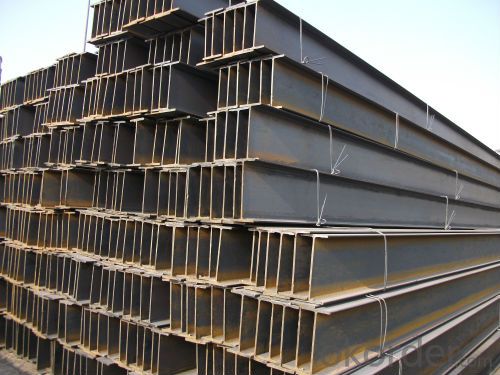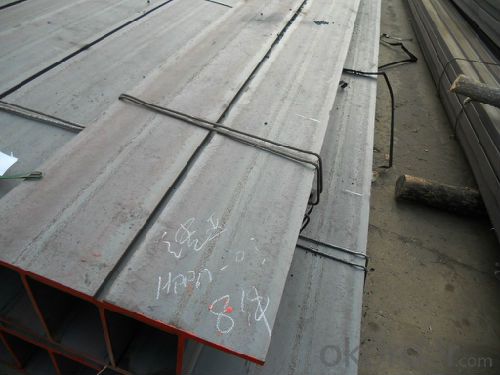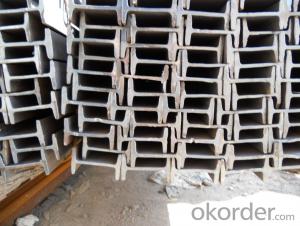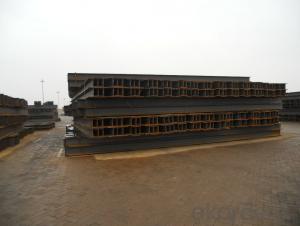H-Type Steel or H Beam Steel Section Made in China
- Loading Port:
- Tianjin
- Payment Terms:
- TT or LC
- Min Order Qty:
- 25 m.t.
- Supply Capability:
- 20000 m.t./month
OKorder Service Pledge
OKorder Financial Service
You Might Also Like
Product Description:
OKorder is offering H-Type Steel or H Beam Steel Section Made in China at great prices with worldwide shipping. Our supplier is a world-class manufacturer of steel, with our products utilized the world over. OKorder annually supplies products to European, North American and Asian markets. We provide quotations within 24 hours of receiving an inquiry and guarantee competitive prices.
Product Applications:
H-Type Steel or H Beam Steel Section Made in China are ideal for structural applications and are widely used in the construction of buildings and bridges, and the manufacturing, petrochemical, and transportation industries.
Product Advantages:
OKorder's H-Type Steel or H Beam Steel Section Made in China are durable, strong, and resist corrosion.
Main Product Features:
· Premium quality
· Prompt delivery & seaworthy packing (30 days after receiving deposit)
· Corrosion resistance
· Can be recycled and reused
· Mill test certification
· Professional Service
· Competitive pricing
Product Specifications:
1. Standard: JIS G3192 OR GB/T11263-2005
2. Grade: Q235/SS400/S235JR
3. Length: 6m-12m
4. Packing:standard export packagin
| STANDARD: JIS G3192 OR GB/T11263-2005 | |||
| H beam Section sizenma(mm) | Weight (kg/m) | ||
| Height×Breadth | Web thichness | Flange thichness | |
| 100×100 | 6 | 8 | 16.9 |
| 125×125 | 6.5 | 9 | 23.6 |
| 150×150 | 7 | 10 | 31.1 |
| 175×175 | 7.5 | 11 | 40.4 |
| 200×200 | 8 | 12 | 49.9 |
| 250×250 | 9 | 14 | 71.8 |
| 300×300 | 10 | 15 | 93.0 |
| 300×300 | 15 | 15 | 105.0 |
| 350×350 | 12 | 19 | 134.9 |
| 400×400 | 13 | 21 | 171.7 |
| 148×100 | 6 | 9 | 20.7 |
| 194×150 | 6 | 9 | 29.9 |
| 244×175 | 7 | 11 | 43.6 |
| 294×200 | 8 | 12 | 55.8 |
| 340×250 | 9 | 14 | 78.1 |
| 390×300 | 10 | 16 | 104.6 |
| 440×300 | 11 | 18 | 120.8 |
| 482×300 | 11 | 15 | 110.8 |
| 488×300 | 11 | 18 | 124.9 |
| 582×300 | 12 | 17 | 132.8 |
| 588×300 | 12 | 20 | 147.0 |
| 100×50 | 5 | 7 | 9.3 |
| 125×60 | 6 | 8 | 13.1 |
| 150×75 | 5 | 7 | 14.0 |
| 175×90 | 5 | 8 | 18.0 |
| 198×99 | 4.5 | 7 | 17.8 |
| 200×100 | 5.5 | 8 | 20.9 |
| 248×124 | 5 | 8 | 25.1 |
| 250×125 | 6 | 9 | 29.0 |
| 298×149 | 5.5 | 8 | 32.0 |
| 300×150 | 6.5 | 9 | 36.7 |
| 346×174 | 6 | 9 | 41.2 |
| 350×175 | 7 | 11 | 49.4 |
| 396×199 | 7 | 11 | 56.1 |
| 400×200 | 8 | 13 | 65.4 |
| 446×199 | 8 | 12 | 65.1 |
| 450×200 | 9 | 14 | 74.9 |
| 496×199 | 9 | 14 | 77.9 |
| 500×200 | 10 | 16 | 88.1 |
| 596×199 | 10 | 15 | 92.4 |
| 600×200 | 11 | 17 | 103.4 |
| 700×300 | 13 | 24 | 181.8 |
| 800×300 | 14 | 26 | 206.8 |
| 900×300 | 16 | 28 | 240.1 |
H beam is widely used in various building structure and engineering structure:
a).used for the plant, high-rise building construction
b).used for the bridge, shipment building
c).used for lifting and transportation machinery, equipment manufacturing base building
d).used for the support, foundation pile manufacturing
FAQ:
Q1: Why buy Materials & Equipment from OKorder.com?
A1: All products offered byOKorder.com are carefully selected from China's most reliable manufacturing enterprises. Through its ISO certifications, OKorder.com adheres to the highest standards and a commitment to supply chain safety and customer satisfaction.
Q2: How do we guarantee the quality of our products?
A2: We have established an advanced quality management system which conducts strict quality tests at every step, from raw materials to the final product. At the same time, we provide extensive follow-up service assurances as required.
Q3: How soon can we receive the product after purchase?
A3: Within three days of placing an order, we will begin production. The specific shipping date is dependent upon international and government factors, but is typically 7 to 10 workdays.
Images:



- Q:How can steel H-beams be protected from corrosion?
- Steel H-beams can be protected from corrosion through various methods. One common method is the application of protective coatings. These coatings act as a barrier between the steel surface and the corrosive environment, preventing the entry of moisture and oxygen, which are key factors in the corrosion process. Coatings such as zinc-based galvanization, epoxy, or polyurethane can be applied to the surface of the H-beams to provide protection. Another effective way to protect steel H-beams from corrosion is through the use of sacrificial anodes. Sacrificial anodes are made of a more reactive metal, such as zinc or aluminum, which are attached to the steel beams. These anodes corrode preferentially to the steel, sacrificing themselves to protect the H-beams from corrosion. Regular maintenance and inspection are also important for the long-term protection of steel H-beams. Any damages or defects in the protective coating should be repaired promptly to prevent corrosion from occurring. Additionally, proper drainage and ventilation systems should be in place to prevent the accumulation of moisture, as this can accelerate the corrosion process. In environments where corrosion is a major concern, such as coastal areas or industrial sites, it may be necessary to employ more advanced corrosion protection methods. These can include cathodic protection systems, which use a direct electrical current to prevent corrosion, or the use of corrosion inhibitors, which are chemicals that can be applied to the steel surface to hinder the corrosion process. Overall, a combination of protective coatings, sacrificial anodes, regular maintenance, and appropriate environmental controls can effectively protect steel H-beams from corrosion and extend their lifespan.
- Q:How are steel H-beams classified based on their shape and size?
- Steel H-beams are classified based on their shape and size by considering factors such as the dimensions of the flanges and the web, as well as the weight per meter. This classification helps identify H-beams suitable for specific structural applications.
- Q:How do steel H-beams perform in high-humidity environments?
- Steel H-beams are generally highly resistant to high-humidity environments. The steel used in H-beams is typically coated or galvanized, providing a protective layer that helps prevent corrosion. This coating acts as a barrier against moisture, reducing the chances of rust formation and degradation. In high-humidity environments, such as coastal areas or regions with high levels of moisture, steel H-beams are designed to withstand the conditions without significant deterioration. The protective coating on the beams ensures their longevity and structural integrity, even in the presence of moisture. However, it is important to note that prolonged exposure to high levels of humidity, along with other factors such as saltwater or chemicals, can still potentially lead to corrosion over time. Regular maintenance and inspection of the steel H-beams should be conducted to identify any signs of corrosion or damage and take appropriate measures to address them. Overall, steel H-beams are a reliable choice for structures in high-humidity environments due to their resistance to moisture and corrosion. Their robust construction and protective coating make them suitable for withstanding the challenges posed by such conditions, ensuring their long-term performance and durability.
- Q:What are the different bolt sizes used for steel H-beams?
- Steel H-beams commonly utilize various bolt sizes, which depend on the particular application and load requirements. M12, M16, M20, and M24 are among the most frequently employed bolt sizes for steel H-beams. The selection of these bolt sizes is determined by the desired strength and load capacity of the specific steel H-beam structure. Furthermore, the length of the bolts can vary depending on the thickness and width of the H-beam. To guarantee optimal strength and stability, it is crucial to refer to engineering specifications and calculations when determining the suitable bolt sizes for a given steel H-beam structure.
- Q:How do Steel H-Beams contribute to the overall natural ventilation of a structure?
- Steel H-Beams do not directly contribute to the natural ventilation of a structure. Natural ventilation refers to the process of using natural forces, such as wind and temperature differences, to circulate air within a building. However, Steel H-Beams can indirectly impact the natural ventilation of a structure by providing the necessary structural support for windows and openings. H-Beams are commonly used in construction to support the weight of the building and distribute it evenly. They are often used in the framework of a structure, allowing for the creation of large openings for windows or doors. These openings play a crucial role in natural ventilation as they allow fresh air to enter the building while allowing stale air to exit. By incorporating Steel H-Beams into the design of a structure, architects and engineers can create larger openings for windows and doors. This allows for increased airflow, enabling the natural ventilation process to be more effective. The H-Beams provide the necessary strength and stability to support these larger openings, ensuring the overall structural integrity of the building. In addition to supporting openings, Steel H-Beams can also be used to create roof structures that facilitate natural ventilation. By creating a pitched or sloped roof design, H-Beams can provide the necessary framework for the installation of vents or skylights. These features allow hot air to rise and escape, drawing in cooler air from lower levels and promoting natural airflow within the building. While Steel H-Beams themselves do not directly contribute to natural ventilation, their presence in the construction of a structure enables the incorporation of windows, doors, and other ventilation features. By providing the necessary structural support, Steel H-Beams play a vital role in enhancing the overall natural ventilation of a building.
- Q:Can steel H-beams be used in residential staircase or railing systems?
- Yes, steel H-beams can be used in residential staircase or railing systems. Steel H-beams are commonly used in construction due to their strength and durability. They provide excellent structural support and can handle heavy loads. When used in staircase or railing systems, steel H-beams offer stability and safety. They can be designed and fabricated to fit the specific requirements and aesthetics of a residential space. Additionally, steel H-beams can be finished with various materials, such as wood or glass, to create a visually appealing staircase or railing system that complements the overall design of the residence.
- Q:How are steel H-beams connected or joined together in construction?
- Steel H-beams, also known as I-beams, find wide application in construction due to their strength and load-bearing capabilities. The connection or joining of these beams is accomplished using various techniques, depending on the specific construction project and its requirements. Welding stands as one of the most prevalent methods for joining steel H-beams. This technique involves heating the two beams at the connection point and subsequently fusing them together using a welding electrode. This results in a robust and enduring bond between the beams. Welding is extensively utilized in construction because it ensures a reliable and sturdy connection, thereby guaranteeing the structural integrity of the building. Bolting serves as another method employed to connect steel H-beams. It entails the use of bolts, nuts, and washers to secure the beams together at the connection point. Holes are drilled through the beams, and bolts are inserted and tightened using a wrench or spanner. Bolting is a popular choice as it allows for easy disassembly and reassembly, making it suitable for projects that may necessitate modifications or relocation in the future. In certain instances, steel H-beams can also be connected using rivets. Riveting involves the drilling of holes through both beams and subsequently inserting cylindrical metal pins known as rivets. These rivets are then hammered or compressed to securely fasten the beams together. Although riveting was extensively employed in the past, it has become less prevalent in modern construction due to the time-consuming nature of the process. Nevertheless, it can still be utilized in specific situations where the desire for aesthetically pleasing or historically significant riveted connections exists. Lastly, adhesive bonding can also be utilized to connect steel H-beams. This method entails the application of a strong adhesive or epoxy to the connection point, followed by the pressing of the beams together. Adhesive bonding offers the advantage of providing a clean and visually appealing connection without the need for visible welds or bolts. However, it is less commonly employed in construction due to the potential challenges involved in achieving a reliable and enduring bond. In conclusion, steel H-beams can be connected or joined together in construction through methods like welding, bolting, riveting, or adhesive bonding. The selection of the joining method depends on the specific project requirements, structural considerations, and aesthetic preferences.
- Q:What are the different design codes for steel H-beams?
- The different design codes for steel H-beams include the American Institute of Steel Construction (AISC) code, European Standard (EN) code, Japanese Industrial Standards (JIS) code, and the British Standards (BS) code. These codes provide guidelines and specifications for the design, fabrication, and use of steel H-beams in various structural applications.
- Q:What is the weight of a standard steel H-beam?
- The weight of a standard steel H-beam can vary depending on its size and dimensions. However, on average, a standard steel H-beam weighs around 33 pounds per foot.
- Q:What are the considerations when designing for corrosion protection of Steel H-Beams?
- When designing for corrosion protection of Steel H-Beams, there are several important considerations that need to be taken into account. These considerations include: 1. Environmental conditions: The first consideration is the environment in which the H-Beams will be located. Factors such as humidity, temperature, and exposure to chemicals or corrosive substances need to be considered. Different environments may require different corrosion protection strategies. 2. Corrosion resistance: The choice of material and surface finish for the H-Beams is crucial for corrosion protection. Typically, steel beams are coated with a protective layer such as galvanized coating, epoxy coating, or a paint system. The selection of the appropriate coating should consider the expected lifespan of the structure and the severity of the corrosive environment. 3. Maintenance requirements: Regular maintenance is essential for preserving the corrosion protection of steel H-Beams. This includes inspections, cleaning, and reapplication of protective coatings when necessary. The design should allow for easy access to all areas of the beams for maintenance purposes. 4. Design details: Certain design details can impact the corrosion protection of H-Beams. For example, sharp edges or crevices can trap moisture and accelerate corrosion. Care should be taken to design smooth, rounded edges and eliminate any potential moisture traps. 5. Compatibility with other materials: If the H-Beams are in contact with other materials such as concrete or dissimilar metals, galvanic corrosion can occur. It is important to consider the compatibility of different materials and take appropriate measures to prevent galvanic corrosion, such as using insulating materials or coatings. 6. Ventilation and drainage: Proper ventilation and drainage are crucial for preventing the buildup of moisture and reducing the risk of corrosion. Designing the structure to allow for adequate airflow and incorporating drainage systems can help to minimize the chances of corrosion. 7. Structural design considerations: The corrosion protection design should not compromise the structural integrity of the H-Beams. The additional weight of coatings or protective systems should be considered in the structural calculations to ensure that the beams can still support the intended loads. In summary, designing for corrosion protection of Steel H-Beams requires careful consideration of environmental conditions, corrosion resistance, maintenance requirements, design details, compatibility with other materials, ventilation and drainage, and structural design considerations. By addressing these considerations, the longevity and durability of the H-Beams can be maximized, reducing the risk of corrosion and ensuring the structural integrity of the overall system.
1. Manufacturer Overview |
|
|---|---|
| Location | |
| Year Established | |
| Annual Output Value | |
| Main Markets | |
| Company Certifications | |
2. Manufacturer Certificates |
|
|---|---|
| a) Certification Name | |
| Range | |
| Reference | |
| Validity Period | |
3. Manufacturer Capability |
|
|---|---|
| a)Trade Capacity | |
| Nearest Port | |
| Export Percentage | |
| No.of Employees in Trade Department | |
| Language Spoken: | |
| b)Factory Information | |
| Factory Size: | |
| No. of Production Lines | |
| Contract Manufacturing | |
| Product Price Range | |
Send your message to us
H-Type Steel or H Beam Steel Section Made in China
- Loading Port:
- Tianjin
- Payment Terms:
- TT or LC
- Min Order Qty:
- 25 m.t.
- Supply Capability:
- 20000 m.t./month
OKorder Service Pledge
OKorder Financial Service
Similar products
New products
Hot products
Hot Searches
Related keywords



























